Drug Treatments for Coronavirus (Covid-19)
Many scientists will agree that cocktail of drugs will be needed to treat the Covid-19 pandemic -- targeting the virus at different molecular pathways....Targeting several pathways is known to be effective in AIDS where both a protease inhibitors and reverse transcriptase inhibitors are used to manage the disease.
Multiple drugs may also be needed because this disease may to be with us for a long time -- If COVID-19 develops a resistance to one drug, then we need others.
We look at several protein targets: RNA-dependent RNA polymerase, papain-like protease the main protease enzyme,and TMPRSS2
Remdesivir -- Gilead Sciences Inc.
Target: RNA-dependent RNA polymerase
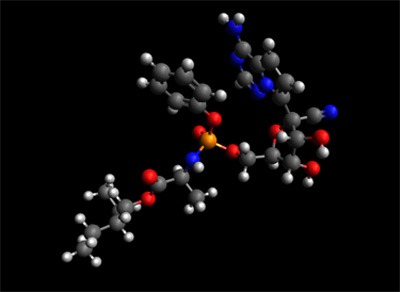
The Remdesivir Molecule
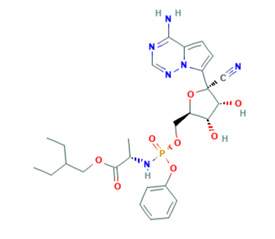
Remdesivir Molecular Formula: C27H35N6O8P
Remdesivir, or GS-5734, is an adenosine triphosphate analog first described in the literature in 2016 as a potential treatment for Ebola. In 2017, its activity against the coronavirus family of viruses was also demonstrated. Remdesivir is also being researched as a potential treatment to SARS-CoV2, the coronavirus responsible for COVID-19.
"..Early treatment with the experimental antiviral drug remdesivir significantly reduced clinical disease and damage to the lungs of rhesus macaques infected with SARS-CoV-2, the coronavirus that causes COVID-19, according to National Institutes of Health scientists..." Antiviral remdesivir prevents disease progression in monkeys with COVID-19.
Mechanism of Action
Coronaviruses replicate by copying their genetic material using an enzyme known as the RNA-dependent RNA polymerase.
Scientists at the University of Alberta have shown that the drug remdesivir is highly effective in stopping the replication mechanism of the coronavirus that causes COVID-19
Calvin J Gordon, Egor P Tchesnokov, Emma Woolner, Jason K Perry, Joy Y. Feng, Danielle P Porter, Matthias Gotte. Remdesivir is a direct-acting antiviral that inhibits RNA-dependent RNA polymerase from severe acute respiratory syndrome coronavirus 2 with high potency. Journal of Biological Chemistry, April 13, 2020;
Götte likens the RNA-dependent RNA polymerase to the engine of the virus, responsible for synthesizing the virus' genome.
Götte’s lab found that the enzymes can incorporate remdesivir (see below image) , which resembles an RNA building block, into new RNA strands. Shortly after adding remdesivir, the enzyme stops being able to add more RNA subunits. This halts genome replication.
See also: Structural basis for inhibition of the RNA-dependent RNA polymerase from SARS-CoV-2 by remdesivir--
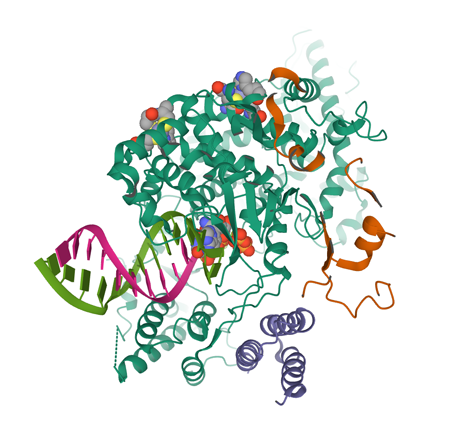
Remdesivir (shown in CPK) above bound to nsp12-nsp7-nsp8
7BV2: The nsp12-nsp7-nsp8 complex bound to the template-primer RNA and triphosphate form of Remdesivir(RTP) Citation: No citation for this structure. -- 3D view from RCSB Protein Data Bank
See: Structural elucidation of SARS-CoV-2 vital proteins: Computational methods reveal potential drug candidates against main protease, Nsp12 polymerase and Nsp13 helicase (Available online 28 April 2020)
Clinical Trials using Remdesivir
Gilead study in patients with moderate disease
Gilead study in patients with severe disease
NIAID study
INSERM study
China study in patient with mild/moderate disease
China study in patients with severe disease
Favipiravir -- Toyama Chemical (Fujifilm group)
Target: RNA-dependent RNA polymerase
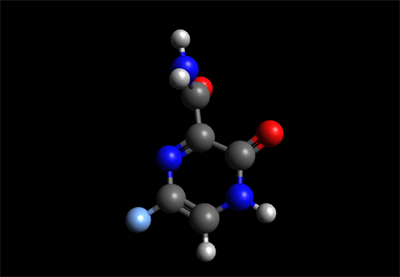
Favipiravir Ball-and-Stick Molecular Model -- Molecular Formula -- C5H4FN3O2
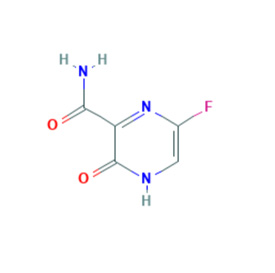 Chemical Structure of Favipiravir
Chemical Structure of Favipiravir
Favipiravir, which has proven to be an effective antiviral drug for fighting RNA infections by inhibiting the RNA-dependent RNA polymerase, or RdRp, is mainly used for treating influenza in Japan and China. Favilavir is a pyrazinecarboxamide derivative.
Mechanism of Action
Favipiravir is a prodrug that is metabolized to its active form, favipiravir-ribofuranosyl-5'-triphosphate (favipiravir-RTP), available in both oral and intravenous formulations. The mechanism of its actions is thought to be related to the selective inhibition of viral RNA-dependent RNA polymerase.
"...The mechanism of the interaction of favipiravir-RTP with RdRp molecule has not been fully elucidated. It is hypothesized that favipiravir may be misincorporated in a nascent viral RNA, or it may act by binding to conserved polymerase domains, thus preventing incorporation of nucleotides for viral RNA replication and transcription. .."source.
Note about Favipiravir and Influenza --"..Taking two antivirals ― favipiravir and oseltamivir ― was more effective for treating severe influenza than taking oseltamivir alone, according to a comparison of results from two clinical trials published online December 11 in the Journal of Infectious Diseases..."
Famotidine -- Active ingredient in Pepcid
Target: Papain-like protease
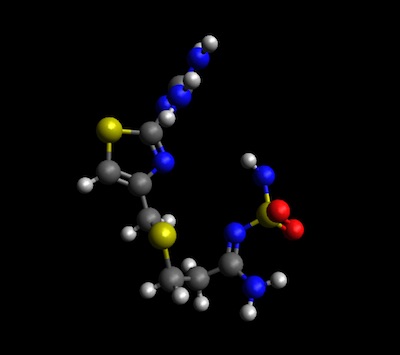
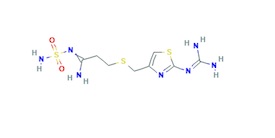
Chemical Structure for Famotidine
Mechanism of Action
Inhibits a viral enzyme papain-like protease, which helps the pathogen replicate.
Updates on Famotidine for Coronavirus
Clinical Trials
New York clinical trial quietly tests heartburn remedy against coronavirus
Chloroquine and Hydroxychloroquine/Plaquenil
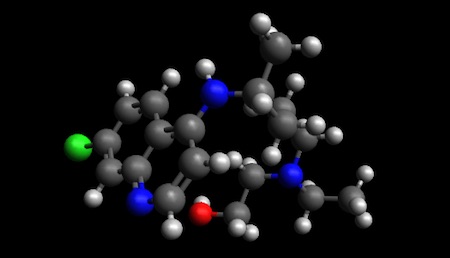
Mechanism of Action
"...Chloroquine (CQ) can raise the pH of endosomes, vesicles inside cells that are hijacked as points of entry by viruses. Endosomes have a slightly acidic pH, which helps facilitate this process. Seidah explains that chloroquine can raise endosomic pH slightly, which prevents fusion and stops the virus from entering the cell. Seidah says chloroquine may also block enzymes involved in the fusion between the virus and lung cells or stymie the viral replication process. Whatever the mechanism, Seidah says, it’s likely a combination of drugs of some kind that will, ultimately, be needed to treat COVID-19..." source: Chloroquine for COVID-19: Cutting Through the Hype
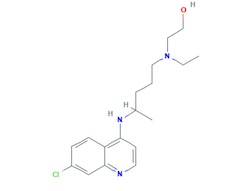
"...Both CQ and HCQ are weak bases that are known to elevate the pH of acidic intracellular organelles, such as endosomes/lysosomes, essential for membrane fusion5. In addition, CQ could inhibit SARS-CoV entry through changing the glycosylation of ACE2 receptor and spike protein..."
Hydroxychloroquine or chloroquine with or without a macrolide for treatment of COVID-19: a multinational registry analysis
"...We were unable to confirm a benefit of hydroxychloroquine or chloroquine, when used alone or with a macrolide, on in-hospital outcomes for COVID-19. Each of these drug regimens was associated with decreased in-hospital survival and an increased frequency of ventricular arrhythmias when used for treatment of COVID-19..." Lancet - May 22, 2020
α-ketoamide inhibitors
SARS-CoV-2 main protease as a Target
The main protease enzyme --- This enzyme cuts the polyproteins translated from viral RNA to yield functional viral proteins.
One of the best-characterized drug targets among coronaviruses is the main protease (Mpro, also called 3CLpro)
From: Crystal structure of SARS-CoV-2 main protease provides a basis for design of improved α-ketoamide inhibitors--Science 24 Apr 2020:
"...We report the x-ray structures of the unliganded SARS-CoV-2 Mpro and its complex with an α-ketoamide inhibitor. This was derived from a previously designed inhibitor but with the P3-P2 amide bond incorporated into a pyridone ring to enhance the half-life of the compound in plasma. On the basis of the unliganded structure, we developed the lead compound into a potent inhibitor of the SARS-CoV-2 Mpro. The pharmacokinetic characterization of the optimized inhibitor reveals a pronounced lung tropism and suitability for administration by the inhalative route..." source
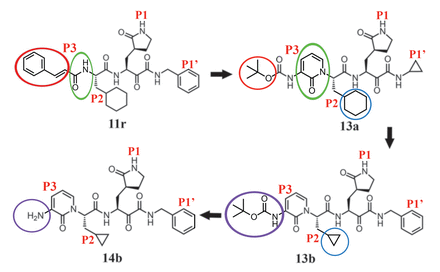
Above: Chemical structures of α-ketoamide inhibitors 11r, 13a, 13b, and 14b. Colored ovals and circles highlight the modifications from one development step to the next (see text). α-ketoamide 13b, inhibited the main protease of the virus, as well as the related Mers virus. The 13b inhibitor was given to mice using a nebuliser without any adverse effects. This suggests direct delivery to the lungs may be feasible in Covid-19 patients. See also: Potent coronavirus drug candidate designed using 3D structure of key viral enzyme.. for commentary.
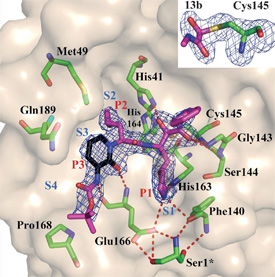
See also: Feline coronavirus drug inhibits the main protease of SARS-CoV-2 and blocks virus replication-- May 3 2020 preprint
"...Here we show a dipeptide-based protease inhibitor drug, GC376, and its analog GC373, are effective inhibitors of the Mpro from both SARS-CoV and SARS-CoV-2 with IC50 values in the nanomolar range. ..They are strong drug candidates for the treatment of human coronavirus infections because they have already been successful in animals (cats). .."
TMPRSS2 Inhibitor Nafamostat
Transmembrane Serine Protease 2 (TMPRSS2) as a Target
"...TMPRSS2 is both the most frequently altered gene in primary prostate cancer and a critical factor enabling cellular infection by coronaviruses, including SARS-CoV-2. The modulation of its expression by sex steroids could contribute to the male predominance of severe infections, and given that TMPRSS2 has no known indispensable functions, and inhibitors are available, it is an appealing target for prevention or treatment of respiratory viral infections..."source -- See also: SARS-CoV-2 Cell Entry Depends on ACE2 and TMPRSS2 and Is Blocked by a Clinically Proven Protease Inhibitor
Both ACE2 and TMPRSS2 are thought to be essential in airway cells for SARS-CoV-2 infection
SARS-CoV-2 initiates human cell entry after the Spike (S) protein present on the envelope binds to a cell membrane receptor called the angiotensin converting enzyme (ACE2). The S protein is cleaved into two subunits, S1 and S2, by a human cell-derived protease, thought to be Furin. S1 then binds to its receptor, ACE2. The other fragment, S2, is cleaved by TMPRSS2, a human cell surface serine protease, resulting in membrane fusion.
Nafamostat is expected to prevent the transmission of new coronavirus infection (COVID-19) --Nafamostat mesylate (brand name: Fusan), which is the drug used to treat acute pancreatitis, may effectively block the requisite viral entry process the new coronavirus (SARS-CoV-2) uses to spread and cause disease (COVID-19). --Nafamostat can prevent the fusion of the envelope of the virus with host cell surface membranes, the first step in infection with the causative virus SARS-CoV-2.
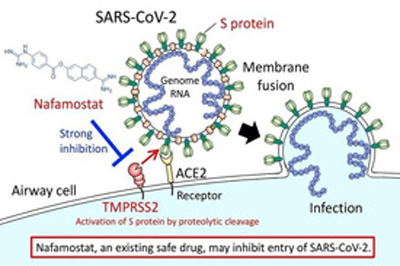
The Cellular Serine Protease TMPRSS2 Primes SARS-2-S for Entry, and a Serine Protease Inhibitor Blocks SARS-CoV-2 Infection of Lung Cells
See also: Nafamostat inhibits SARS-CoV-2 infection, preventing COVID-19 transmission
Triple Combination of Drugs for Coronavirus
Triple combination of interferon beta-1b, lopinavir–ritonavir, and ribavirin in the treatment of patients admitted to hospital with COVID-19: an open-label, randomised, phase 2 trial...
"...This was a multicentre, prospective, open-label, randomised, phase 2 trial in adults with COVID-19 who were admitted to six hospitals in Hong Kong. Patients were randomly assigned (2:1) to a 14-day combination of lopinavir 400 mg and ritonavir 100 mg every 12 h, ribavirin 400 mg every 12 h, and three doses of 8 million international units of interferon beta-1b on alternate days (combination group) or to 14 days of lopinavir 400 mg and ritonavir 100 mg every 12 h (control group). The primary endpoint was the time to providing a nasopharyngeal swab negative for severe acute respiratory syndrome coronavirus 2 RT-PCR, and was done in the intention-to-treat population. ...Interpretation--- Early triple antiviral therapy was safe and superior to lopinavir–ritonavir alone in alleviating symptoms and shortening the duration of viral shedding and hospital stay in patients with mild to moderate COVID-19. Future clinical study of a double antiviral therapy with interferon beta-1b as a backbone is warranted..." Lancet May 9, 2020
Ribavirin is a guanosine (ribonucleic) analog used to stop viral RNA synthesis and viral mRNA capping, thus, it is a nucleoside inhibitor. Ribavirin is a prodrug, which when metabolized resembles purine RNA nucleotides. In this form, it interferes with RNA metabolism required for viral replication.
Lopinavir–ritonavir-- Lopinavir/ritonavir (LPV/r), sold under the brand name Kaletra among others, is a fixed dose combination medication for the treatment and prevention of HIV/AIDS. It combines lopinavir with a low dose of ritonavir. It is generally recommended for use with other antiretrovirals.
In 2020, a non-blinded, randomized trial found lopinavir/ritonavir was not useful to treat severe COVID-19. In this trial the medication was started typically around 13 days after the start of symptoms. source wikipedia.
SENOLYTIC AND ANTI-AGING MOLECULES
RAPAMYCIN ---The mechanistic target of rapamycin (mTOR) pathway has a central role in cell activation...
METFORMIN -- The diabetes drug metformin used by some for anti-aging may diminish benefits of aerobic exercise...
QUERCETIN-- AND WITH DASATINIB--The senolytic cocktail, dasatinib plus quercetin, which causes selective elimination of senescent cells...
FISETIN--Of the 10 flavonoids tested, fisetin was the most potent senolytic...
EGCG- The most active component of green tea....
NAD BOOSTERS --'...The cells of the old mice were indistinguishable from the young mice, after just one week of treatment...
SULFORAPHANE-- An isothiocyanate present in cruciferous vegetables activates antioxidant and anti-inflammatory responses by ...
UROLITHIN --Metabolite of Pomegranate compound with anti-aging effects passes human trial...
MITO-Q -- A water soluble form of CoQ10 that has excellent absorption and high bioavailability...
HONOKIOL - A bioactive natural product derived from Magnolia Bark have demonstrated ...
CURCUMIN AND ANALOGS -Recent research is focused on the design and synthesis of curcumin analogs as antiproliferative and anti-inflammatory agents...
PIPERLONGUMINE - A natural product from the Long pepper with high bioavailability...
RESVERATROL -- Shown to increase life in yeast and flatworms...
ALLICIN -- Allicin is a compound produced when garlic is crushed or chopped. ...
VITAMIN D3 -- Production of the active forms of Vitamin D are reduced by 50% as a result of an age-related decline
TOCOTRIENOL(AND WITH QUERCETIN) --Tocotrieniols have been found to exert a synergistic antitumor effect on cancer cells when given in combination....
The Cannabidiol Molecule
Cannabidiol (CBD is the major non-psychoactive component of Cannabis and is being looked at by major drug and consumer companies for various medical and social uses.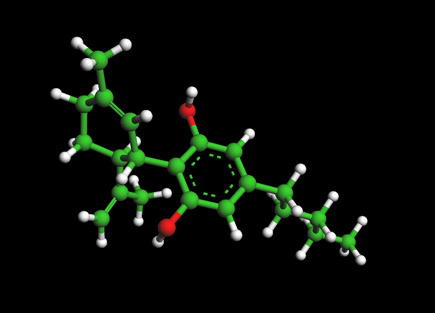
MOLECULES OF DISEASE
Small Molecules
Proteins